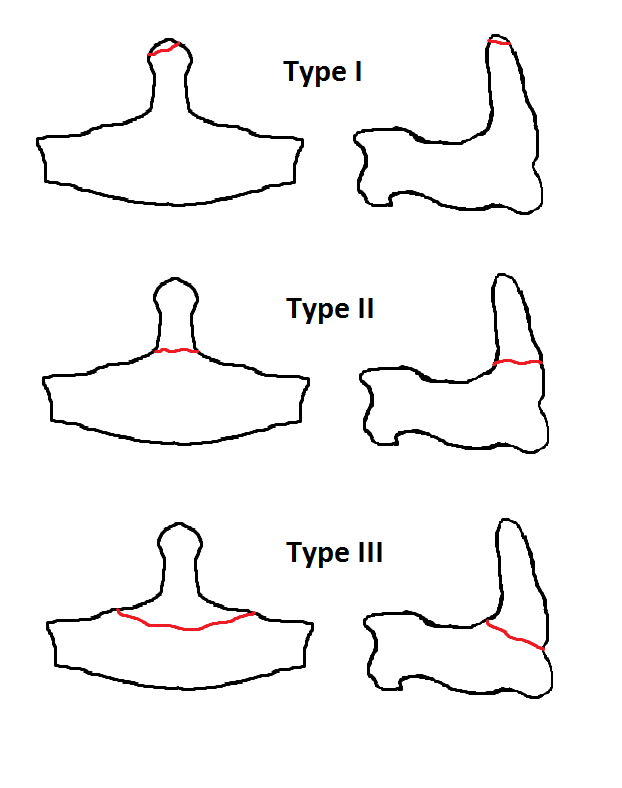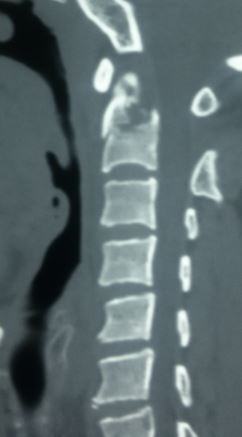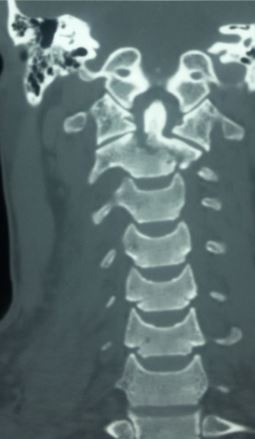[1]
Robinson AL, Möller A, Robinson Y, Olerud C. C2 Fracture Subtypes, Incidence, and Treatment Allocation Change with Age: A Retrospective Cohort Study of 233 Consecutive Cases. BioMed research international. 2017:2017():8321680. doi: 10.1155/2017/8321680. Epub 2017 Jan 15
[PubMed PMID: 28182084]
Level 2 (mid-level) evidence
[2]
Deluca A, Wichlas F, Deininger C, Traweger A, Mueller EJ. Reevaluation of a classification system: stable and unstable odontoid fractures in geriatric patients-a radiological outcome measurement. European journal of trauma and emergency surgery : official publication of the European Trauma Society. 2022 Aug:48(4):2967-2976. doi: 10.1007/s00068-022-01985-0. Epub 2022 May 21
[PubMed PMID: 35597894]
[3]
Bakhsh A, Alzahrani A, Aljuzair AH, Ahmed U, Eldawoody H. Fractures of C2 (Axis) Vertebra: Clinical Presentation and Management. International journal of spine surgery. 2020 Dec:14(6):908-915. doi: 10.14444/7139. Epub 2020 Dec 29
[PubMed PMID: 33560250]
[4]
Benca E, Zderic I, van Knegsel KP, Caspar J, Hirtler L, Fuchssteiner C, Strassl A, Gueorguiev B, Widhalm H, Windhager R, Varga P. Biomechanical Assessment of Fracture Loads and Patterns of the Odontoid Process. Spine. 2022 Sep 1:47(17):1212-1220. doi: 10.1097/BRS.0000000000004369. Epub 2022 Jul 14
[PubMed PMID: 35853162]
[5]
Sommer F, Kirnaz S, Goldberg J, McGrath L Jr, Navarro-Ramirez R, Gadjradj P, Medary B, Härtl R. Treatment of Odontoid Fractures in Elderly Patients Using C1/C2 Instrumented Fusion Supplemented With Bilateral Atlantoaxial Joint Spacers: A Case Series. International journal of spine surgery. 2022 Jun:16(3):442-449. doi: 10.14444/8250. Epub
[PubMed PMID: 35772974]
Level 2 (mid-level) evidence
[6]
Alluri R, Bouz G, Solaru S, Kang H, Wang J, Hah RJ. A Nationwide Analysis of Geriatric Odontoid Fracture Incidence, Complications, Mortality, and Cost. Spine. 2021 Jan 15:46(2):131-137. doi: 10.1097/BRS.0000000000003734. Epub
[PubMed PMID: 33038203]
[7]
Gold C, Seaman S, Yamaguchi S. Relationship between odontoid fracture angle and cervical sagittal balance. Surgical neurology international. 2021:12():157. doi: 10.25259/SNI_829_2020. Epub 2021 Apr 14
[PubMed PMID: 33948327]
[8]
Florman JE, Gerstl JVE, Kilgallon JL, Riesenburger RI. Fibrous Nonunion of Odontoid Fractures: Is It Safe To Accept Nonoperative Management? A Systematic Review. World neurosurgery. 2022 Aug:164():298-304. doi: 10.1016/j.wneu.2022.05.116. Epub 2022 Jun 2
[PubMed PMID: 35659587]
Level 1 (high-level) evidence
[9]
Lennarson PJ, Mostafavi H, Traynelis VC, Walters BC. Management of type II dens fractures: a case-control study. Spine. 2000 May 15:25(10):1234-7
[PubMed PMID: 10806499]
Level 2 (mid-level) evidence
[10]
Wilson C, Hoyos M, Huh A, Priddy B, Avila S, Mendenhall S, Anokwute MC, Eckert GJ, Stockwell DW. Institutional review of the management of type II odontoid fractures: associations and outcomes with fibrous union. Journal of neurosurgery. Spine. 2021 Jan 22:34(4):623-631. doi: 10.3171/2020.8.SPINE20860. Epub 2021 Jan 22
[PubMed PMID: 33482645]
[11]
Butt BB, Gagnet P, Patel R, Aleem I. Congenital defect of the posterior arch of C1: a case report. Journal of spine surgery (Hong Kong). 2021 Jun:7(2):214-217. doi: 10.21037/jss-20-628. Epub
[PubMed PMID: 34296035]
Level 3 (low-level) evidence
[12]
Windsor TA, Tewelde SZ, Blosser KM, Richardson AC. An odontoid fracture and vertebral artery injury in fast-track. Clinical case reports. 2020 Sep:8(9):1847-1849. doi: 10.1002/ccr3.2952. Epub 2020 May 25
[PubMed PMID: 32983515]
Level 3 (low-level) evidence
[13]
Rao G, Apfelbaum RI. Odontoid screw fixation for fresh and remote fractures. Neurology India. 2005 Dec:53(4):416-23
[PubMed PMID: 16565532]
[14]
Fazzolari B, Jannelli G, Conti E, Delitala A, Tessitore E, Brunori A. Clinical and radiological outcome after minimally invasive surgical approach for type II unstable odontoid fractures. Neuro-Chirurgie. 2021 Jul:67(4):350-357. doi: 10.1016/j.neuchi.2020.11.014. Epub 2020 Dec 15
[PubMed PMID: 33338497]
[15]
Rizvi SAM, Helseth E, Aarhus M, Harr ME, Mirzamohammadi J, Rønning P, Mejlænder-Evjensvold M, Linnerud H. Favorable prognosis with nonsurgical management of type III acute odontoid fractures: a consecutive series of 212 patients. The spine journal : official journal of the North American Spine Society. 2021 Jul:21(7):1149-1158. doi: 10.1016/j.spinee.2021.02.003. Epub 2021 Feb 10
[PubMed PMID: 33577924]
[16]
Moscolo F, Meneghelli P, Boaro A, Impusino A, Locatelli F, Chioffi F, Sala F. The use of Grauer classification in the management of type II odontoid fracture in elderly: Prognostic factors and outcome analysis in a single centre patient series. Journal of clinical neuroscience : official journal of the Neurosurgical Society of Australasia. 2021 Jul:89():26-32. doi: 10.1016/j.jocn.2021.04.015. Epub 2021 Apr 29
[PubMed PMID: 34119278]
[17]
Sucu HK. A True Percutaneous Anterior Odontoid Screw Fixation: The Results of 42 Cases by a Single Surgeon. World neurosurgery. 2022 Oct:166():e892-e904. doi: 10.1016/j.wneu.2022.07.125. Epub 2022 Aug 7
[PubMed PMID: 35948230]
Level 3 (low-level) evidence
[18]
Coleman N, Chan HH, Gibbons V, Baker JF. Comparison of Hard and Soft Cervical Collars for the Management of Odontoid Peg Fractures in the Elderly. Geriatric orthopaedic surgery & rehabilitation. 2022:13():21514593211070263. doi: 10.1177/21514593211070263. Epub 2022 Mar 18
[PubMed PMID: 35320993]
[19]
Honda A, Michihata N, Iizuka Y, Mieda T, Takasawa E, Ishiwata S, Matsui H, Fushimi K, Yasunaga H, Chikuda H. Clinical features and early post-operative complications of isolated C2 odontoid fractures: a retrospective analysis using a national inpatient database in Japan. European spine journal : official publication of the European Spine Society, the European Spinal Deformity Society, and the European Section of the Cervical Spine Research Society. 2021 Dec:30(12):3631-3638. doi: 10.1007/s00586-021-06862-9. Epub 2021 May 6
[PubMed PMID: 33959795]
Level 2 (mid-level) evidence
[20]
Fiani B, Doan T, Covarrubias C, Shields J, Sekhon M, Rose A. Determination and optimization of ideal patient candidacy for anterior odontoid screw fixation. Surgical neurology international. 2021:12():170. doi: 10.25259/SNI_165_2021. Epub 2021 Apr 19
[PubMed PMID: 34084598]
[21]
Koshimizu H, Nakashima H, Ito K, Ando K, Kobayashi K, Kato F, Sato K, Deguchi M, Matsubara Y, Inoue H, Kanemura T, Urasaki T, Yoshihara H, Wakao N, Shinjo R, Imagama S. Risk factors of non-union in Anderson-D'Alonzo type III odontoid fractures with conservative treatment. Journal of orthopaedics. 2021 Mar-Apr:24():280-283. doi: 10.1016/j.jor.2021.03.012. Epub 2021 Mar 29
[PubMed PMID: 33897130]
[22]
Yee TJ, Strong MJ, Willsey MS, Oppenlander ME. Cervical 1-2 Posterior Instrumented Fusion Utilizing Computer-Assisted Navigation With Harvest of Rib Strut Autograft: 2-Dimensional Operative Video. Operative neurosurgery (Hagerstown, Md.). 2021 May 13:20(6):E433. doi: 10.1093/ons/opab029. Epub
[PubMed PMID: 33571358]
[23]
Jain AK, Tawari M, Rathore L, Sahana D, Mishra H, Kumar S, Sahu RK. An experience with Goel-Harms C1-C2 fixation for type II odontoid fractures. Journal of craniovertebral junction & spine. 2022 Apr-Jun:13(2):175-181. doi: 10.4103/jcvjs.jcvjs_22_22. Epub 2022 Jun 13
[PubMed PMID: 35837432]
[24]
Govindasamy R, Preethish-Kumar V, Gopal S, Rudrappa S. Is Transoral Surgery Still a Relevant Procedure in Atlantoaxial Instability? International journal of spine surgery. 2020 Oct:14(5):657-664. doi: 10.14444/7096. Epub 2020 Oct 19
[PubMed PMID: 33077434]
[25]
Wolan-Nieroda A, Maciejczak A, Drużbicki M, Guzik A. Determinants of health-related quality of life in patients with fracture of the axis vertebrae. Scientific reports. 2021 Sep 24:11(1):19075. doi: 10.1038/s41598-021-98476-w. Epub 2021 Sep 24
[PubMed PMID: 34561492]
Level 2 (mid-level) evidence
[26]
Tyagi G, Patel KR, Singh GJ, Uppar AM, Beniwal M, Rao KVLN, Pruthi N, Bhat D, Somanna S, Chandramouli B, Dwarakanath S. Anterior Odontoid Screw Fixation for C2 Fractures: Surgical Nuances, Complications, and Factors Affecting Fracture Union. World neurosurgery. 2021 Aug:152():e279-e288. doi: 10.1016/j.wneu.2021.05.077. Epub 2021 May 28
[PubMed PMID: 34058365]
[27]
Duransoy YK, Mete M, Ünlü Ünsal Ü, Aydın M, Zileli M. Anterior odontoid screw fixation using Acutrak screw: Report of 19 patients. Ulusal travma ve acil cerrahi dergisi = Turkish journal of trauma & emergency surgery : TJTES. 2021 Jul:27(4):472-477. doi: 10.14744/tjtes.2020.86345. Epub
[PubMed PMID: 34213004]
[28]
Pongmanee S, Kaensuk S, Sarasombath P, Rojdumrongrattana B, Kritworakarn N, Liawrungrueang W. Anterior screw fixation for type II odontoid process fractures: A single-center experience with the double Herbert screw fixation technique (Retrospective cohort study). Annals of medicine and surgery (2012). 2022 Feb:74():103337. doi: 10.1016/j.amsu.2022.103337. Epub 2022 Feb 5
[PubMed PMID: 35198171]
Level 2 (mid-level) evidence
[29]
Acharya S, Kumar M, Ghosh JD, Adsul N, Chahal RS, Kalra KL. Morphometric parameters of the odontoid process of C2 vertebrae, in Indian population, a CT evaluation. Surgical neurology international. 2021:12():494. doi: 10.25259/SNI_417_2021. Epub 2021 Sep 30
[PubMed PMID: 34754544]
[30]
Choudhary KS, Doddamani RS, Devarajan LJ, Agrawal M, Sawarkar D, Meena RK, Varma S, Kumar A, Singh P, Chandra PS, Kale SS. Feasibility of Double Anterior Odontoid Screw: A CT-Based Morphometric Analysis of the Axis in Adult Indian Population. Neurology India. 2020 Nov-Dec:68(6):1361-1366. doi: 10.4103/0028-3886.304125. Epub
[PubMed PMID: 33342869]
Level 2 (mid-level) evidence
[31]
Zhao R, Ding W, Li X, Han FY, Yang D, Yang S. Application of the O-arm Intraoperative Imaging System to Assist Anterior Cervical Screw Fixation for Odontoid Fractures. Journal of visualized experiments : JoVE. 2022 Aug 30:(186):. doi: 10.3791/64471. Epub 2022 Aug 30
[PubMed PMID: 36121255]
[32]
Abreu PG, Romero C, Lourenço JAB, Pappamikail L, Brito M, Teles P, Correia J. Case report: Challenging post-traumatic pseudoarthrosis of C2 odontoid fracture and extreme C1-C2 subluxation. Surgical neurology international. 2022:13():137. doi: 10.25259/SNI_10_2022. Epub 2022 Apr 8
[PubMed PMID: 35509539]
Level 3 (low-level) evidence
[33]
Li Y, Lin J, Wang Y, Luo H, Wang J, Lu S, Xu Y. Comparative study of 3D printed navigation template-assisted atlantoaxial pedicle screws versus free-hand screws for type II odontoid fractures. European spine journal : official publication of the European Spine Society, the European Spinal Deformity Society, and the European Section of the Cervical Spine Research Society. 2021 Feb:30(2):498-506. doi: 10.1007/s00586-020-06644-9. Epub 2020 Oct 23
[PubMed PMID: 33098009]
Level 2 (mid-level) evidence
[34]
Kedia S, Sawarkar D, Sharma R, Mansoori N, Lalwani S, Gupta D, Kumar R, Kale SS. Endoscopic Anterior Odontoid Screw Fixation for the Odontoid Fracture: A Cadaveric Pilot Study. Asian journal of neurosurgery. 2021 Jan-Mar:16(1):67-71. doi: 10.4103/ajns.AJNS_312_20. Epub 2021 Mar 20
[PubMed PMID: 34211869]
Level 3 (low-level) evidence
[35]
Lebl DR, Avrumova F, Abjornson C, Cammisa FP. Cervical Spine Navigation and Enabled Robotics: A New Frontier in Minimally Invasive Surgery. HSS journal : the musculoskeletal journal of Hospital for Special Surgery. 2021 Oct:17(3):333-343. doi: 10.1177/15563316211026652. Epub 2021 Jul 1
[PubMed PMID: 34539275]
[36]
Issa M, Kiening KL, Unterberg AW, Scherer M, Younsi A, Fedorko S, Oskouian RJ, Chapman JR, Ishak B. Morbidity and Mortality in Patients over 90 Years of Age Following Posterior Stabilization for Acute Traumatic Odontoid Type II Fractures: A Retrospective Study with a Mean Follow-Up of Three Years. Journal of clinical medicine. 2021 Aug 24:10(17):. doi: 10.3390/jcm10173780. Epub 2021 Aug 24
[PubMed PMID: 34501228]
Level 2 (mid-level) evidence
[37]
Dou H, Xie C, Zhu S, Wang X, Huang Q, Zhou F. Feasibility analysis of the use of anterior screw fixation in the treatment of pediatric odontoid fracture. Translational pediatrics. 2021 Apr:10(4):967-972. doi: 10.21037/tp-21-101. Epub
[PubMed PMID: 34012844]
Level 2 (mid-level) evidence
[38]
Watts A, Athanassacopoulos M, Breakwell L, Chiverton N, Cole A, Ivanov M, Tomlinson J. Management of C2 odontoid peg fragility fractures - A UK survey of spinal surgeons. Injury. 2022 Mar:53(3):1057-1061. doi: 10.1016/j.injury.2021.09.057. Epub 2021 Oct 1
[PubMed PMID: 34635337]
Level 3 (low-level) evidence
[39]
Rizvi SAM, Helseth E, Rønning P, Mirzamohammadi J, Harr ME, Brommeland T, Aarhus M, Høstmælingen CT, Ølstørn H, Rydning PNF, Mejlænder-Evjensvold M, Utheim NC, Linnerud H. Odontoid fractures: impact of age and comorbidities on surgical decision making. BMC surgery. 2020 Oct 14:20(1):236. doi: 10.1186/s12893-020-00893-7. Epub 2020 Oct 14
[PubMed PMID: 33054819]
[40]
Rizvi SAM, Helseth E, Harr ME, Mirzamohammadi J, Rønning P, Mejlænder-Evjensvold M, Linnerud H. Management and long-term outcome of type II acute odontoid fractures: a population-based consecutive series of 282 patients. The spine journal : official journal of the North American Spine Society. 2021 Apr:21(4):627-637. doi: 10.1016/j.spinee.2020.11.012. Epub 2020 Dec 17
[PubMed PMID: 33346157]
[41]
Yamaguchi S, Park BJ, Takeda M, Mitsuhara T, Shimizu K, Chen PF, Woodroffe RW. Healing process of Type II odontoid fractures after C1-C2 posterior screw fixation: Predictive factors for pseudoarthrosis. Surgical neurology international. 2022:13():116. doi: 10.25259/SNI_198_2022. Epub 2022 Mar 31
[PubMed PMID: 35509583]
[42]
Ricciardi L, Trungu S, Scerrati A, De Bonis P, Rustemi O, Mazzetto M, Lofrese G, Cultrera F, Barrey CY, Di Bartolomeo A, Piazza A, Miscusi M, Raco A. Odontoid screw placement for Anderson type II odontoid fractures: how do duration from injury to surgery and clinical and radiological factors influence the union rate? A multicenter retrospective study. Journal of neurosurgery. Spine. 2020 Oct 2:34(1):27-31. doi: 10.3171/2020.6.SPINE20318. Epub 2020 Oct 2
[PubMed PMID: 33007754]
Level 2 (mid-level) evidence
[44]
Patkar S. Unstable odontoid fractures: technical appraisal of anterior extrapharyangeal open reduction internal fixation for irreducible unstable odontoid fractures. Patient series. Journal of neurosurgery. Case lessons. 2021 Nov 15:2(20):CASE21501. doi: 10.3171/CASE21501. Epub 2021 Nov 15
[PubMed PMID: 36061093]
Level 3 (low-level) evidence
[45]
Maeda K, Ichiba T. Unusual Clinical Course of Odontoid Fracture: Transient Prehospital Cardiopulmonary Arrest. Cureus. 2020 Dec 18:12(12):e12157. doi: 10.7759/cureus.12157. Epub 2020 Dec 18
[PubMed PMID: 33489569]
[46]
Zygogiannis K, Georgoulis JD, Antonopoulos SI, Gourtzelidis G, Chatzikomninos I. Cruciate Paralysis Following a Displaced Type II Odontoid Fracture: A Case Report. Cureus. 2022 May:14(5):e25181. doi: 10.7759/cureus.25181. Epub 2022 May 21
[PubMed PMID: 35747018]
Level 3 (low-level) evidence
[47]
Agunbiade S, Belton PJ, Mesfin FB. Spinal Cord Transection in a Type II Odontoid Fracture From a Ground-Level Fall. Cureus. 2020 Dec 28:12(12):e12342. doi: 10.7759/cureus.12342. Epub 2020 Dec 28
[PubMed PMID: 33520537]



